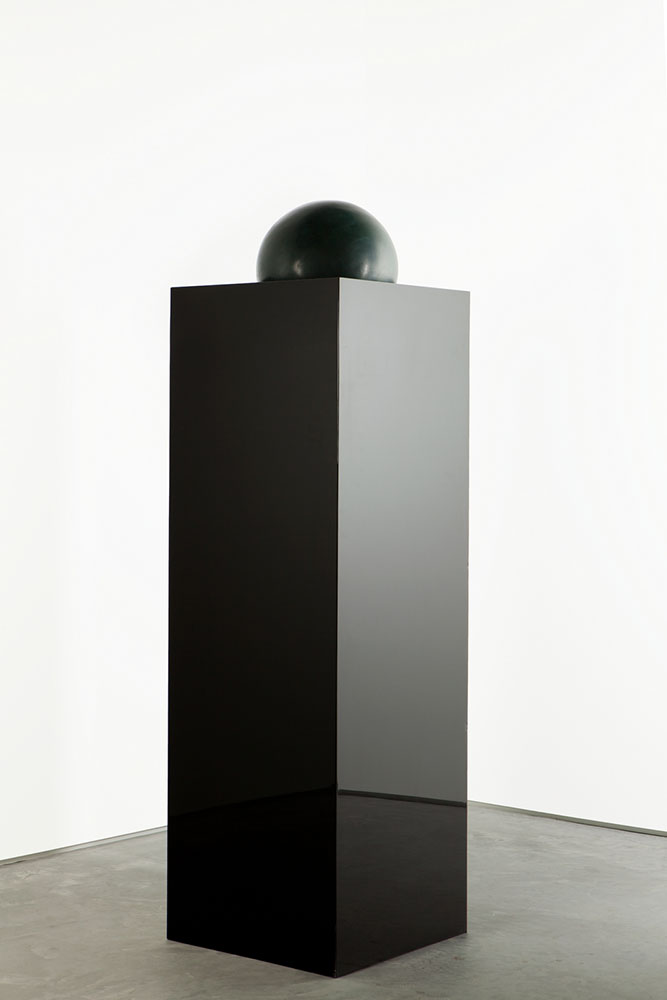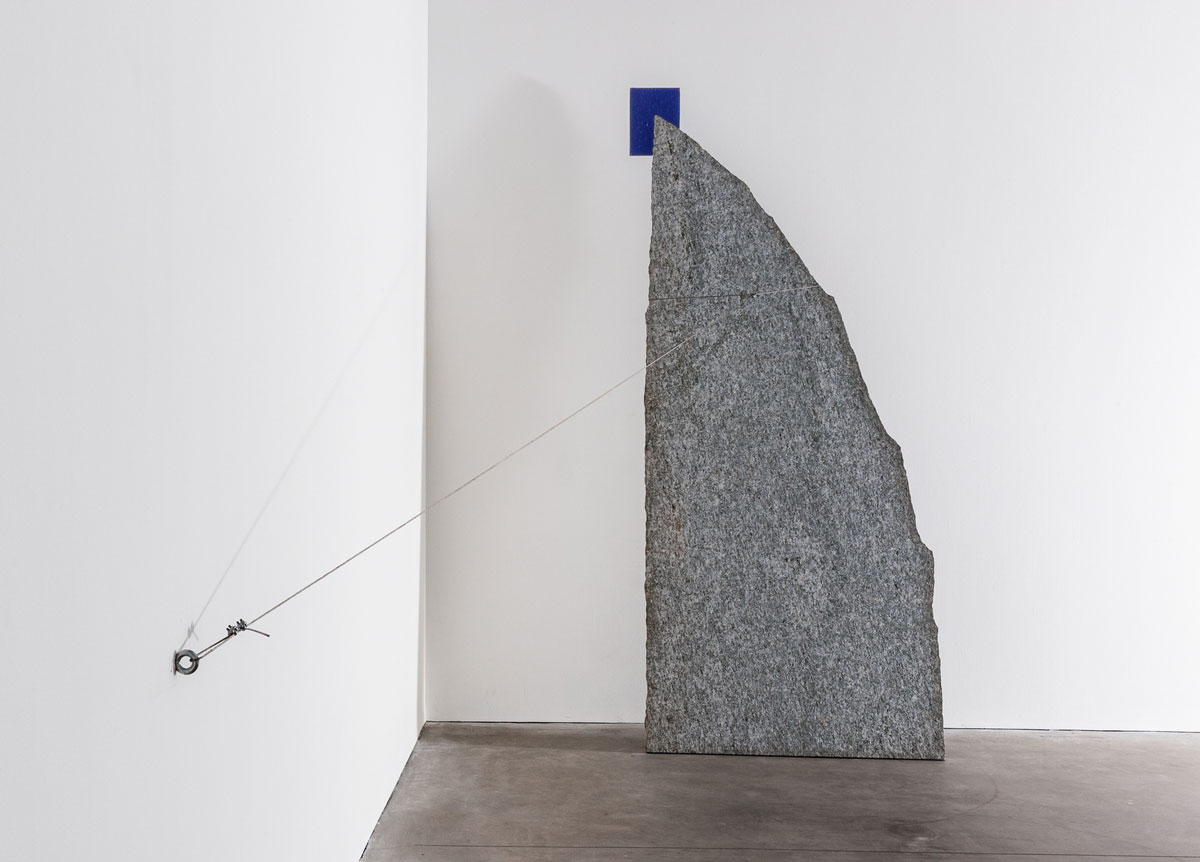PRESENTATION: Giovanni Anselmo-Beyond the Horizon, Part II
![Giovanni Anselmo, Untitled (Toward the Ultramarine) [Senza titolo (Verso oltremare)], 1982–89, Stones, canvases and mural painting, 330 x 170 x 525 cm, Patrimonio Artístico Fundación “la Caixa”, © Giovanni Anselmo](http://www.dreamideamachine.com/web/wp-content/uploads/2024/02/00-Senza-titolo_Verso-oltremare.jpg) Even though he shared certain artistic concerns and reflections of his time, being a referent of Arte Povera, which emerged in Italy in the late 1960s, Giovanni Anselmo avoided labeling by forging a corpus beyond styles and trends over the course of several decades. In 1965, Giovanni Anselmo experienced the dissolution of his “own shadow in the infinite” at the peak of the volcano Stromboli, when he became aware that he was part of a universe under constant transformation. This led him to present reality through materials and actions that occur due to interaction with the public or the forces around them (Part I).
Even though he shared certain artistic concerns and reflections of his time, being a referent of Arte Povera, which emerged in Italy in the late 1960s, Giovanni Anselmo avoided labeling by forging a corpus beyond styles and trends over the course of several decades. In 1965, Giovanni Anselmo experienced the dissolution of his “own shadow in the infinite” at the peak of the volcano Stromboli, when he became aware that he was part of a universe under constant transformation. This led him to present reality through materials and actions that occur due to interaction with the public or the forces around them (Part I).
By Dimitris Lempesis
Photo: Guggenheim Museum Bilbao Archive

The exhibition “Beyond the Horizon”, a comprehensive analysis of the artistic practice of Giovanni Anselmo envisioned as a path or a journey that connects the most emblematic works in Anselmo’s career with other site-specific pieces and reveals the powerful relationship between Anselmo’s oeuvre and the architectural space in which they are exhibited. This selection of more than 40 works surveys the creative approach of an artist who actively and perceptively presented the surrounding energies and the incommensurable nature of the forces and dynamics governing the universe. Giovanni Anselmo. Beyond the Horizon offers the opportunity to learn about the broad range of mediums and materials used by the Italian artist, as well as the recurring themes that defined his artistic vocabulary, such as space, time, orientation, magnetic fields, and the planet’s gravitational forces. Giovanni Anselmo began his artistic career with the practices of drawing and oil painting. However, he decided to abandon both mediums in 1965 after experiencing the dissolution of his “own shadow in the infinite” at the peak of the volcano Stromboli, as he documented in a famous photograph that can be seen at the start of the exhibition. At that moment, the artist became aware of being an integral part of an immense universe under constant transformation, and after that he turned away from the idea of representation and advocated presenting reality through materials and actions. The starting point of the show is the first sculptural inquiries that Anselmo made after that revelatory experience. These sculptures exposed the original foundation of his purpose: to challenge the notion of fixed structures. One example is Untitled (1966), a thin iron bar that remains standing yet reveals its instability with the tiniest vibration. Thus, the artist managed to prevent his works from crystallizing into a single image or static object and instead turned them into spaces of encounter open to continuous interaction with the observers or the forces around them. Anselmo thus managed to present reality by revealing energy through its own action. These early works made him a key reference of the Arte Povera group when it first emerged in Italy in the late 1960s. In reality, Giovanni Anselmo had barely started his own artistic career, which would go on to avoid labeling. Indeed, even though his works reflect certain concerns and artistic reflections of his day, Anselmo forged his own artistic corpus beyond styles and trends over the course of several decades. After the mid-1960s, his works were based on reflections on the order of things and the cyclical course of natural phenomena in immediate relation with the real world. The artist crafted his works to simply and poetically address fundamental physical conditions and relationships, like the equivalence between mass and energy or the precariousness of balance, using real objects and existing materials that revealed a great deal of ambivalence: there is a physical part and there is an invisible part that acts, that is manifested through action. Thus, Anselmo summoned and harnessed invisible universal energies like gravity to come up with pieces that build a bridge between our understanding of an infinite cosmos and our daily individual experience of the here and now. Giovanni Anselmo. Beyond the Horizon reveals an artist whose creations are situated at a fascinating boundary between the visible and the invisible, between everyday reality and the forces driving the world. This exhibition offers visitors the possibility of familiarizing themselves with the recurrent categories and motifs shaping Giovanni Anselmo’s artistic corpus, like energy, space, time, orientation, magnetic fields, and the planet’s gravitational forces. A good example of this is “Senza titolo (Struttura che mangia)”, (1968) one of the granite blocks falls due to the decomposition of the lettuce, capturing one of the ways natural energy transforms, in addition to revealing the force of gravity and alluding to the passage of time. Anselmo also uses another kind of time, one that stretches over millennia and is revealed by movement and material transformation, that is, by nature’s “desire.” Thus, “Trecento millioni di anni” (1969), made of anthracite, is comprised of a piece of metal and a lamp whose heat strives to go back in time to help the petrified fragment come alive again the way it was 300 million years ago. Some works included in the exhibition are related to orientation, like “Direzione” (1967–68), whose compass, inserted in a block of granite cut in the shape of a triangle, points northward. This block of granite, one of the oldest and most durable materials, is alive with latent energy and invisible forces. The sculpture is not limited to the physical space it occupies; instead, the compass transports us to the magnetic fields and poles shown by its magnetic needle. Other works deal with the force of gravity, like “Untitled” (1984–91), in which two stone blocks are suspended in balance over canvas with steel cables. The exhibition also presents an artist who poeticizes with language, which played a fundamental role in his work after the 1970s in projections of words like “detail,” “everything,” “visible,” or “infinite” on different surfaces, including walls, the gallery floor, the ceiling, corners, pipes, a baseboard, or even the visitors themselves. These light rays only become meaningful when they encounter a material body, showing that the world is made of details, or that something may apparently be invisible even though it exists. The richness and complexity of his approach was enhanced in creations like “Entrare nell’ opera” (1971) and “Il panorama con mano che lo indica” (1984). The former reveals his desire to truly be inside the work of art and experience it as a specific place more than an alien object, while the latter appeals to us directly by suggesting we become aware of our form of perception. Finally worth noting in this exhibition is the work “Mentre verso oltremar il colore solleva la pietra“ (1995–2024) designed specifically for the gallery space that houses it and crafted with local limestone from a quarry in the Lastur region.
Photo: Giovanni Anselmo, Untitled (Toward the Ultramarine) [Senza titolo (Verso oltremare)], 1982–89, Stones, canvases and mural painting, 330 x 170 x 525 cm, Patrimonio Artístico Fundación “la Caixa”, © Giovanni Anselmo
Info: Curator: Gloria Moure, Guggenheim Museum Bilbao, Avenida Abandoibarra 2, Bilbao, Spain, Duration: 9/2-19/5/2024, Days & Hours: Tue-Sun 10:00-19:00, www.guggenheim-bilbao.eus/
![Left: Giovanni Anselmo, Untitled, 1968, Stones and cable, 2 elements, 21,5 x 63 x 41,5 cm aprox., Private collection / Kunstmuseum Liechtenstein, Vaduz, © Giovanni Anselmo, Photo: © Stefan AltenburgerRight: Giovanni Anselmo Untitled (Structure that Eats) [Senza titolo (Scultura che mangia)], 1968, Granite, copper, and lettuce, 62 x 25 x 25 cm, Citadellarte - Fondazione Pistoletto, Biella, © Giovanni Anselmo](http://www.dreamideamachine.com/web/wp-content/uploads/2024/02/Struttura-che-mangia.jpg)
Right: Giovanni Anselmo, Untitled (Structure that Eats) [Senza titolo (Scultura che mangia)], 1968, Granite, copper, and lettuce, 62 x 25 x 25 cm, Citadellarte – Fondazione Pistoletto, Biella, © Giovanni Anselmo
![Left: Giovanni Anselmo, Untitled [(The Wet Cotton Is Thrown onto the Glass and It Stays there)] [Senza titolo (Il cotone bagnato viene buttato sul vetro e ci resta)], 1968, Glass, cotton, sack, zinc bucket, water, and sawdust, 210 x 210 x 50 cm, The Sonnabend Homem Collection. On loan to Fundacão de Serralves – Museu de Arte Contemporânea de Serralves, Porto, © Giovanni Anselmo, Photo: © Filipe BragaRight: Giovanni Anselmo, Torsion (Torsione), 1968, Iron and fabric, 160 x 160 cm, GAM – Galleria Civica d’Arte Moderna e Contemporanea, Fondazione Guido et Ettore De Fornaris, Turin, © Giovanni Anselmo, Courtesy: Fondazione Torino Musei, 2008, Photo: © Studio Fotografico Gonella](http://www.dreamideamachine.com/web/wp-content/uploads/2024/02/Torsione.jpg)
Right: Giovanni Anselmo, Torsion (Torsione), 1968, Iron and fabric, 160 x 160 cm, GAM – Galleria Civica d’Arte Moderna e Contemporanea, Fondazione Guido et Ettore De Fornaris, Turin, © Giovanni Anselmo, Courtesy: Fondazione Torino Musei, 2008, Photo: © Studio Fotografico Gonella

